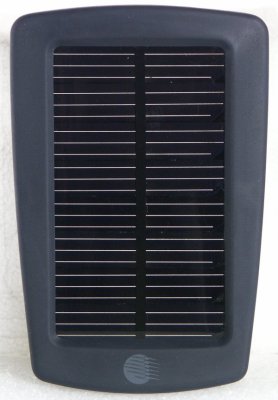Engineers seem to like this name very much, as they decided to give it to their device. Well, let's see what this Scott is capable of.
First of all, let's adduce the specification:
- Output voltage: 2.5 ~ 14 V
- Maximum output current: 0.05 ~ 2 A
- Solar battery capacity: 0.4 W
- Bundled batteries: 2x600 mAh
- Battery types: NiMH, NiCd, RAM
- Ambient temperature: 0 ~ +35 oC
- Humidity: up to 90%
- Dimensions(LxWxH): 98x64x31 mm
- Weight including batteries: 134 g
- Made in: Germany
- Package Contents: solar panel, cable, adapter, 2 batteries.
The device is made of black plastic, it's narrowed to the bottom. The front panel houses a rectangular solar module. The rear panel hosts an external power supply connector (12V, to charge Scotty from the electrical system of a car), charge indicator and a bay for AA batteries. There is a connector on the bottom to plug various power consuming devices. The rear side also contains a convenient clip to carry Scotty on your belt or on a rucksack strap. This clip turns into a device stand in a car or at home. The stand allows to orientate the device to maximum light. When on a stand, the device is raised approximately by 30 degrees.



Mobile phones and other devices cannot be charged from solar batteries directly. At first Scotty batteries are charged. Only after that they charge the connected devices. You can use nickel-cadmium and nickel-metal hydride batteries. The device has overcharge and deep discharge protections. You can also use regular alkaline batteries, but only when you charge a mobile phone, GPS module, or other devices.

Indicator on the rear panel shows the charge level of Scotty batteries – the faster the LED is blinking, the fuller the batteries are charged.
The bundled cable allows to charge Nokia phones without an adapter. You will need adapters (or different cables) for other phone models as well as PDA and GPS modules. Scotty starts working only when you plug the adapter cable.

According to the manufacturer, Scotty will be able to fully charge its bundled batteries:
| | Out-of-doors charge time | Southern window charge time |
| Summer, sunny | 1 – 2 days | 3 – 5 days |
| Small clouds | 4 – 8 days | 1.5 – 3 weeks |
| Autumn, sunny | 1.5 – 3 days | 4 – 8 days |
| Winter, sunny | 3 – 6 days | 1 – 2 weeks |
According to the manufacturer, 12 hours of charging bundled batteries in the bright sun should be enough for 1-1.5 hour talk over a cellular phone or 30-60 hours of stand-by mode. These data are provided for a 3.6 V phone battery.
It took Scotty less than an hour to charge Siemens ME45 from 50 to 100 percents. Unfortunately, we didn't manage to conduct thorough tests. We had this device for only a couple of days. But still, we can draw some conclusions:
This charger will be useful for hikers and car travellers. Though it takes much time to charge the bundled batteries in the sun, you can still plug it to a car accumulator or insert batteries to charge a mobile phone, which makes this device very useful for a hiker away from regular 220 V outlets. That is this device is sort of an adapter from regular AA batteries to a battery of a phone, GPS module, PDA or other low-power portable devices.
This device is presently not widely available on retail, but there already appeared one distributor intending to sell it on the market at about 70 USD when purchased in small lots starting from 100 items.
Write a comment below. No registration needed!





